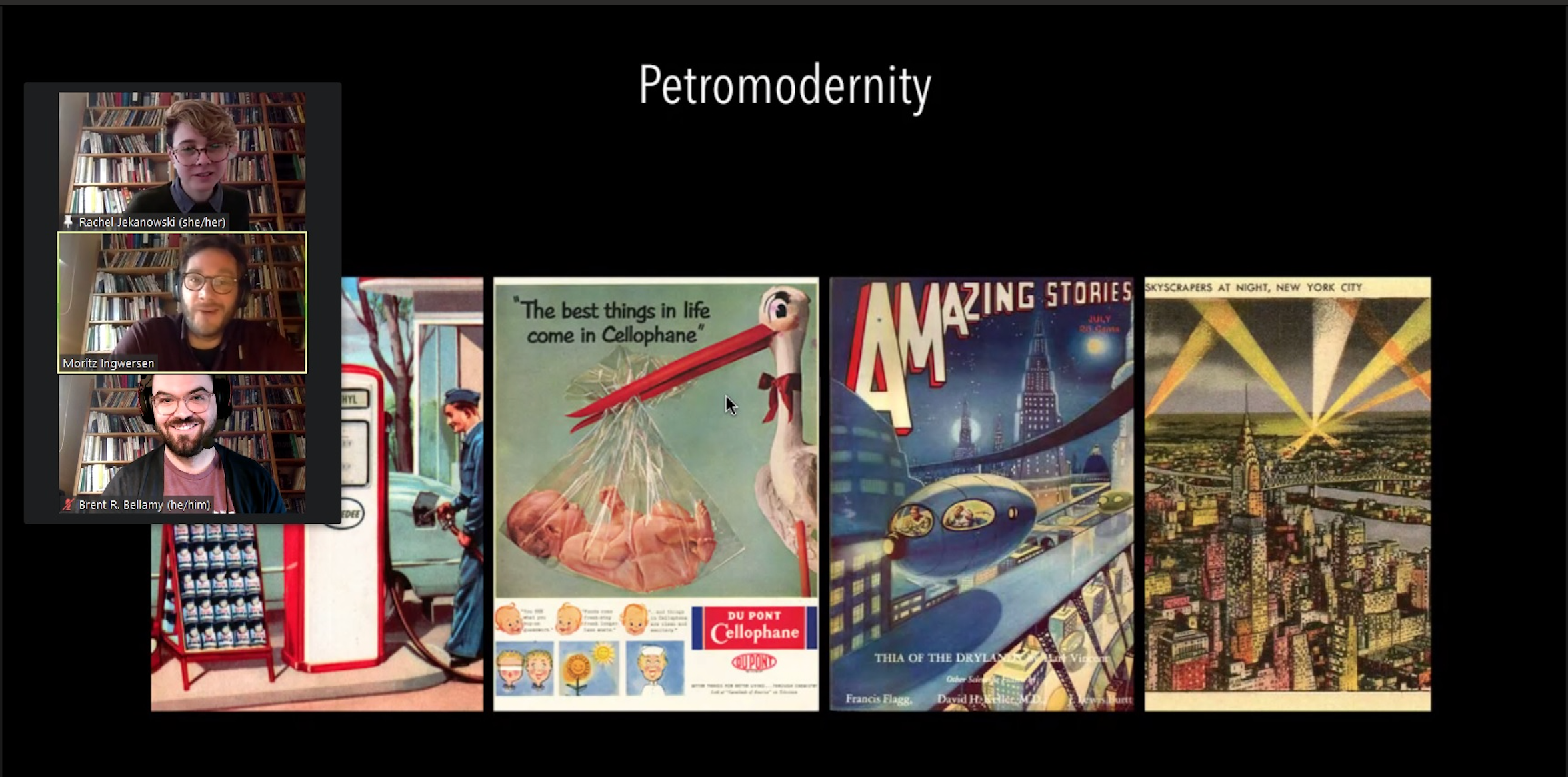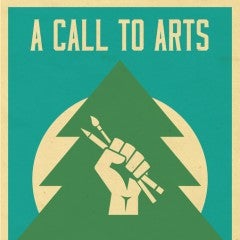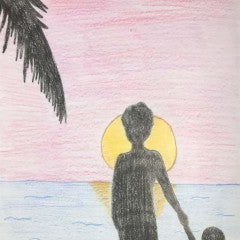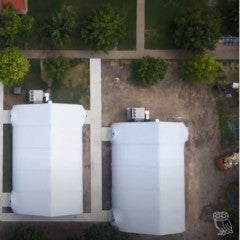In Summer 2021, three researchers co-taught a remote course on "North American Petrocultures" at TU Dresden (Technische Universität Dresden) in Germany. Brent Ryan Bellamy (Trent University, Ontario), Moritz Ingwersen (TU Dresden), and Rachel Webb Jekanowski (Memorial University, Newfoundland and Labrador) present an introduction to and discussion of their collaborative experience in teaching an environmental humanities course.
"North American Petrocultures" was designed to introduce students at TU Dresden—an Institute of Technology with strong engineering and environmental science departments—to the energy humanities and foreground the socio-cultural traces of fossil fuels with a focus on North American literature and media. Offered in English within the Faculty of Linguistics, Literature, and Cultural Studies, the students were predominantly German pursuing English and American Studies at the Master’s level, many of whom shared the goal of becoming high school teachers. Prior to taking the course, our students had little exposure to the environmental humanities or to the specific Indigenous and settler colonial contexts framing Canadian and American petrocultures. Situated near one of Europe’s largest active lignite mining areas in the borderlands of Germany, Poland, and Czech Republic, TU Dresden offers a unique environment for amplifying a humanities approach to petrocultures within a transcultural setting.
"North American Petrocultures" emerged from a previous experiment with cross-continental course design and remote delivery undertaken by Moritz and Brent at the University of Konstanz (Germany) after the start of the COVID-19 pandemic. After Moritz was hired as Chair of North American Literature at TU Dresden, he invited Brent and Rachel to join him in developing a similar course at TU Dresden. As friends and colleagues working across related fields of literature, film, and cultural studies, we wanted to sensitize students to their own embeddedness in transnational petrocultures. At the same time, we sought to center the role of the arts and literature in critical imaginations of ecological futures beyond a technological fix.
Framed by an introduction to petrocultures and energy humanities scholarship (with assigned readings by Stephanie LeMenager, Imre Szeman and Dominic Boyer, Amitav Ghosh, and Patricia Yaeger), the course was organized into four thematic blocks: 1) mid-century petromodernity, 2) the aesthetics of petro-horror and extractivism, 3) environmental racism and Indigenous resistance, and 4) ecotopia. The concept of an “energy unconscious” provided the guiding metaphor for tracing the illegible, repressed, and sublimated socio-material dimensions of fossil fuels within cultural texts. Perhaps the core challenge of this course was to balance a critical and transmedial introduction to key examples of the American petrotopian imaginary with cultural representations of environmental catastrophe, energy infrastructures, and the entanglements between North American petrocultures and settler colonialism, all of which was new to most of the students.
The course syllabus can be found here, with the weekly schedule and a complete list of assigned readings and screenings.
The course increased energy literacy among TU Dresden students through cultural-studies methods for examining the traces of the fossil fuels regime in both North American cultural production and the students' relation to the material. An emergent component was what such reckoning meant in terms of decolonial pedagogy across continents. One of our repeated conversations when developing our syllabus was how to meaningfully teach Indigenous content and racial justice within an entry-level energy studies course. How would we teach North American studies in Europe from a critical perspective, when our students likely will not have the cultural or historical contexts for settler colonialism and Indigenous sovereignty struggles, which are fundamental to understanding contemporary North American petrocultures?
As three white scholars, two of whom live and work on occupied Indigenous land, we tried to approach this material with care, an openness to self-critique, and a commitment to foregrounding the links between oil, racism, settler colonialism, and environmental harm. We were also acutely aware of the challenges of teaching Indigenous content without becoming tokenistic. We opened the first class lecture with territorial acknowledgements for the lands on which we live and work, framing this exercise as part of a broader, semester-long conversation about positionality, power, and histories of place.
While we attended to questions surrounding Indigenous sovereignty throughout the semester, we pushed our direct engagement with Black and Indigenous authors to the second half of the course, a decision about which we remain ambivalent. Rather than positioning negotiations of environmental justice and Black/Indigenous world-building as an afterthought or corrective, we hoped that this structure would offer an effective frame for establishing a trajectory from the dubiously aestheticized to the real, embodied, and emplaced political dimensions of contemporary energy culture.
In the weeks addressing environmental justice and post-apocalypse, for instance, we assigned the documentary There’s Something in the Water (dir. Elliot Page and Ian Daniel, 2019), Elizabeth LaPensée’s side-scroller game Thunderbird Strike (2017), and Octavia E. Butler’s novel The Parable of the Sower (1993). Earlier in the course, we introduced students to ideas of petro-horror and extractivism via Fritz Leiber’s “The Black Gondolier” (1967), Paolo Bacigalupi’s “The People of Sand and Slag” (2004), Warren Cariou’s “An Athabasca Story” (2012), and Edward Burtynsky’s “Landscapes of Oil: A Photo-Essay” (2015).
Especially with regard to the concept of extractivism, we had to negotiate our differing pedagogical approaches on how to best introduce students to its implications at the nexus of aesthetics and politics. Should students’ understanding be shaped by the contributions of white energy scholars—such as Imre Szeman’s essay “On the Politics of Extraction” (2017) and Edward Burtynsky’s Anthropocene photography—or by the visual culture and theoretical contributions of Indigenous and front-line scholars and activists—as reflected in Leanne Betasamosake Simpson’s 2013 interview with Naomi Klein “Dancing the World into Being” and a collection of Indigenous-authored “Land-Back” memes in the wake of Idle No More and Standing Rock? While both perspectives could offer similar tools of analysis, each presumes a different positioning vis-à-vis the everyday experiences of extractive regimes on bodies, communities, and environments.
Fostering an atmosphere of collegiality was key to our multi-faculty pedagogy. We recommend to anyone inviting guests to join or co-facilitate: include co-teachers in discussion and activities. This approach encouraged students to treat our meetings as a place they could think out loud. Because the three of us have different training, we had the opportunity to model genuine questions. Even though this polyphony of teacherly voices was sometimes challenging, we came away with the impression that by embracing generative disagreement among ourselves students also felt encouraged and empowered to engage in a more open dialogue. Intellectual community flourishes when students and colleagues feel comfortable asking questions from where they are experientially, intellectually, and materially; when we recognize that we’re all working through this material together.
One example of how we activated this mindset: we adapted Jennifer Wenzel’s Oil Inventory assignment. Students worked through the theory in creative contributions that ranged from bio-horror short stories about literalized bodies of oil and fictional diary entries of an oil addict to a cartography of household petromedia and post-apocalyptic dreams of extractivist landscapes. They did this on their own, exploring their connections to the fossil regime through daily activities to locate its traces in their lives. For more on Wenzel’s assignment, see Bellamy’s Fieldwork in the Energy Humanities.
Another example, this time collaborative: we ran a unit on ecotopia. Students started off by reading “Ecotopia Emerging: Alternative Speculation on Ecologically Sounds Worlds,” an image-word collection of architectural speculations about ecotopian cities (in Utopia Forever: Visions of Architecture and Urbanism, eds. Robert Klanten and Lukas Feireiss, 2011). They started with a critical take on these proposals. For instance, of Zoo of Infectious Species they asked, “Why would we want to keep the deadliest virus species alive (and waste so much energy on keeping them alive)?” The example Vegetal City prompted the question: “How do they ensure that the living spaces are safe as they are dynamic in growth?” The critical mode was familiar to them, especially after units on petromodernity, petro-sublime, and extractivism and energy justice. The questions above came from writing prompts they submitted before our meeting.
In class we reviewed their prompts, and then we flipped the script. Students were to create their own utopia using a Utopia Generator designed by Geoff Manaugh (also from Utopia Forever) in breakout groups. Group members took turns selecting options from tables: Possible Landscapes of Utopia, Utopia's Relationship to the Planetary Surface, Possible Residents of Utopia, and so on. The exercise works because everyone has a chance to reflect on the choices so far, but one can make one’s own call. For instance, the first two options selected in one group were a city of canals and a desert, so when prompted to choose the relationship to the planetary surface, the next person chose “underwater.” The framed contingency of the lists and taking turns choosing generates delightful mental maps of unreal places.

Emergent storytelling offers a different mode for thought than criticism. It feels easy to get started because there are clear options and directions, and the complexity and nuance builds from the cumulative impact of each decision. These are not the kind of options we find in petromodernity, and they perform a different role: the pedagogical aim here is to experience the creative work of synchronizing our imaginations.
Using this approach, we inverted the way we had been operating and remade the hierarchy of criticism into the horizontality of collaboration. Inspired by critical pedagogy, specifically in how it draws on creativity and asks students to learn through experience, we built self-reflection into the exercise. After the utopias were imagined, students were prompted to discuss their experience in the exercise:
- What surprises you most about this place?
- What would you add to make this place better?
- What energy powers this place and how is it organized? For example, has it moved beyond petroculture/petrotopia? What has changed, what has stayed the same in regards to petromodernity? Is energy access extractivist, egalitarian, something else?
- Where do you fit in this community? What role do you have in this culture?
Alongside the honing of knowledge and critical acumen, the work of the imagination opens students up to the possibility of solving problems in unique, idiosyncratic, or clever ways. We encourage them to recognize the imaginative spark and risks of presenting a plan for energy justice and social life. This kind of playful, expansive thinking also helps to activate students’ sense of agency and critical competency in shaping a world after oil.
This brings us back to the affordances of co-teaching: the course wouldn’t have been as successful as it was without our disagreements. Such discussions emphasize the fault lines in our training and our understanding of teaching in the environmental humanities. They push us to better articulate our rationale and our politics, making us over into participants in the online classroom.
Upon reviewing the student essays and first ideas for term paper topics we were struck by the students’ eagerness to engage the transnational dimension of petrocultures. Some addressed, for example, dialogues among Indigenous resistance movements in Canada and the experience of cultural minorities displaced by extractive projects nearby, or brought their own biographies of migration from the Middle East to bear on critiques of the American energy unconscious. Others reflected on their involvement in climate justice movements in relation to ecotopian world-building. Ultimately, we come away from this course with a sense of hope and the confirmation that critical pedagogies on petroculture need to emerge from a dialogue between specific emplaced life-worlds and their planetary, transcultural inter-dependencies.
Brent Ryan Bellamy is a contract instructor at Trent University in Peterborough, Ontario (Canada). Previously, Brent designed the online course Literature and Globalization focused on energy regimes for the Department of English. Students explore the global cultures of energy, starting from their own apartments and connecting to distant locations and practices through commodity chains and energy inventories.
Moritz Ingwersen is Chair of North American Literature and Critical Future Studies at TU Dresden. Moritz holds a joint Ph.D. in Cultural Studies and English from Trent University, Canada, and the University of Cologne, Germany. His research and teaching are informed by his M.A. in English and Physics and engage intersections among the environmental humanities, science fiction studies, and STS.
Rachel Webb Jekanowski is an incoming Assistant Professor in the Department of English at Memorial University - Grenfell, Newfoundland and Labrador (Canada). Rachel recently completed a Banting postdoctoral research fellowship at Memorial University in St. John’s, and has taught as a per course instructor at Memorial University and Lakehead University - Orillia (Ontario). Her research and teaching focuses on energy systems, environments, and visual culture. Rachel also works as a community organizer around issues of climate justice, equity, and decolonization.







